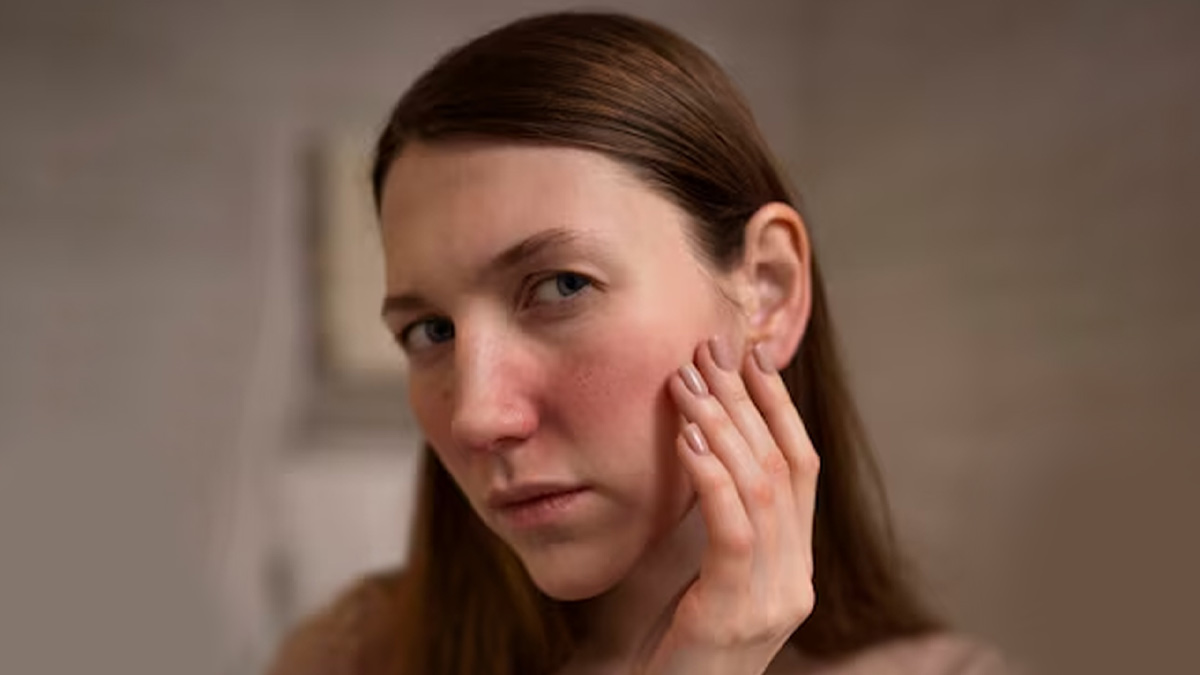
Seeing red spots on your skin can be quite alarming, especially when they seem to pop up out of nowhere. You might find yourself feeling self-conscious, wondering if it’s something serious or just a minor annoyance. These spots can come in various shapes and sizes, often leading to questions about their origins and how to make them disappear. Understanding why red spots appear on the skin and how to get rid of them is essential for managing this condition effectively. In this article, we list common causes of red spots and provide tips on how to treat and prevent them.
Table of Content:-
Common Causes of Red Spots on the Skin
Heat Rash

According to Medicine and Dentistry, heat rash is a skin irritation characterised by redness, tiny raised bumps, chafing, and a burning or itchy feeling. It occurs when sweat gets trapped under the skin and is especially common in hot and humid weather and can affect people of all ages. The rash often appears in areas of the body where sweat accumulates, such as the neck, chest, and back.
Allergic Reactions
Allergies are a common cause of red spots on the skin. These reactions can result from contact with allergens, such as pollen, certain foods, pet dander, or skin care products. When the body comes into contact with an allergen, it releases histamines, which lead to inflammation, redness, and itching. Allergic reactions can appear as hives, which are red, raised welts that often appear suddenly and can spread quickly.
Also Read: Troubled With Redness From Pimples? Try These Home Remedies To Get Rid Of This Inflammation
Eczema (Atopic Dermatitis)

Eczema is a chronic skin condition characterised by dry, red, and inflamed patches of skin. According to StatPearls, people with eczema often experience dry and itchy skin that is more susceptible to infection. The condition is frequently referred to as the 'itch that rashes' because the dryness and itchiness trigger a rash from constant scratching or rubbing.
Keratosis Pilaris
Keratosis pilaris is a common skin condition where small, red, rough bumps appear on the skin, particularly on the arms, thighs, and cheeks. It occurs when hair follicles become clogged with dead skin cells. This condition is harmless but can cause cosmetic concerns for some individuals. It tends to be more prevalent in people with dry skin or a history of eczema.
Petechiae
Petechiae are small, pinpoint red spots that can appear on the skin when tiny blood vessels, called capillaries, break. They are usually harmless, but their appearance can sometimes indicate an underlying health issue. According to StatPearls, The main underlying causes of petechiae include thrombocytopenia, platelet dysfunction, coagulation disorders, and weakened blood vessel integrity.
Rosacea

Rosacea is a chronic skin condition that causes persistent redness and visible blood vessels on the face. It can also lead to red spots, swelling, and sometimes pus-filled bumps. According to a 2023 study, rosacea primarily affects the cheeks, nose, chin, and forehead. It can also impact the eyes, leading to conditions like conjunctivitis, blepharitis, and, in rare cases, keratitis.
Also Read: Redness On Scalp? Expert Lists Signs Of Scalp Eczema And Its Types
How to Get Rid of Red Spots on Skin
While some red spots on the skin may disappear on their own, others might require specific treatments or lifestyle changes to address the underlying cause. Here are some tips on how to manage and get rid of red spots on the skin:
Cool Down for Heat Rash

If you develop a heat rash, staying in a cooler environment and wearing loose-fitting, breathable clothing can help alleviate symptoms. Applying calamine lotion or hydrocortisone cream may also soothe itching and reduce redness.
Identify and Avoid Allergens
If your red spots are caused by an allergic reaction, identifying and avoiding the triggering allergen is crucial. For mild cases, over-the-counter antihistamines and topical creams can help relieve itching and reduce inflammation. For severe allergic reactions, medical intervention may be necessary.
Moisturise for Eczema

Regularly moisturising your skin can help prevent eczema flare-ups. Choose fragrance-free, hypoallergenic moisturisers to lock in moisture. Topical corticosteroids may be prescribed by a doctor to reduce inflammation during flare-ups.
Exfoliate for Keratosis Pilaris
To manage keratosis pilaris, gently exfoliate the affected areas with a mild scrub to remove dead skin cells. Moisturisers containing lactic acid or urea can also help smooth the skin. Though keratosis pilaris has no cure, consistent care can improve its appearance over time.
Manage Petechiae
Petechiae often resolve on their own once the underlying cause, such as an infection or medication side effect, is addressed. If you notice petechiae along with other symptoms, such as fever, fatigue, or a change in consciousness, seek medical attention immediately.
Protect Your Skin for Rosacea
For people with rosacea, gentle skin care is essential. Avoid harsh scrubs or soaps, and use sunscreen daily, as sun exposure can worsen the condition. Your doctor may recommend prescription treatments, such as topical antibiotics or oral medications to control symptoms.
[Disclaimer: This article contains information for informational purposes only, hence, we advise you to consult your own professional if you are dealing with any health issues to avoid complications.]
Also watch this video
How we keep this article up to date:
We work with experts and keep a close eye on the latest in health and wellness. Whenever there is a new research or helpful information, we update our articles with accurate and useful advice.
Current Version